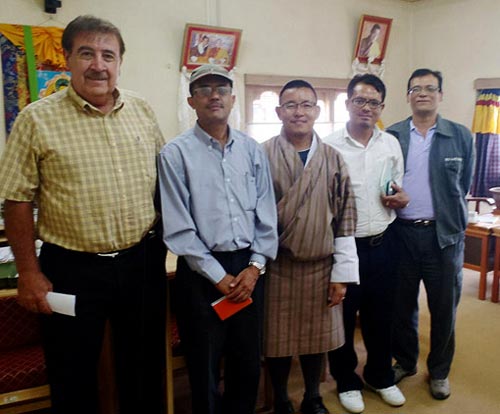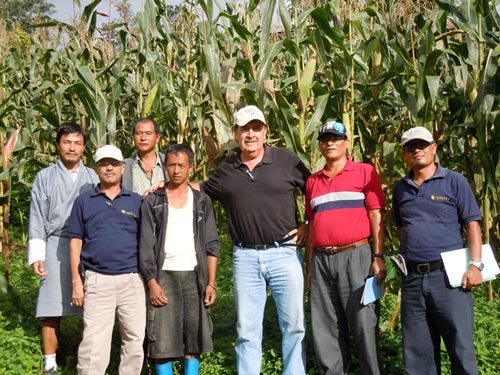 The similarities between the hills of Nepal and the maize producing areas of Bhutan encourage stronger cooperation between the two countries. To discuss this cooperation, a team of scientists from CIMMYT’s Hill Maize Research Project (HMRP) visited Bhutan during 24-28 August 2012. The team consisted of Nirmal Gadal (agronomist), Dilli KC (seed value chain and marketing expert), and G. Ortiz-Ferrara (team leader), and aimed to monitor the maize crop season, assess the gray leaf spot (GLS) disease development, observe seed multiplication efforts of the two recently released open-pollinated maize varieties, and discuss continued collaboration between CIMMYT and the Renewable Natural Resources (RNR) program under the Research and Development Center (RDC) of Bhutan.
The similarities between the hills of Nepal and the maize producing areas of Bhutan encourage stronger cooperation between the two countries. To discuss this cooperation, a team of scientists from CIMMYT’s Hill Maize Research Project (HMRP) visited Bhutan during 24-28 August 2012. The team consisted of Nirmal Gadal (agronomist), Dilli KC (seed value chain and marketing expert), and G. Ortiz-Ferrara (team leader), and aimed to monitor the maize crop season, assess the gray leaf spot (GLS) disease development, observe seed multiplication efforts of the two recently released open-pollinated maize varieties, and discuss continued collaboration between CIMMYT and the Renewable Natural Resources (RNR) program under the Research and Development Center (RDC) of Bhutan.
CIMMYT has been providing technical support to Bhutan since 2003. According to G.B. Chetri, agriculture specialist and officiating director at the Department of Agriculture – DoA, this collaboration has been highly successful: “The maize research and production in the country has been strengthened as a result of that collaboration. A similar model needs to be followed in other crop commodities including rice and wheat.” He specifically appreciated the technical support to the RNR, including access to improved maize germplasm from global CIMMYT maize programs and from the National Maize Research Program (NMRP) of the Nepal Agricultural Research Council (NARC), and providing training on disease identification, breeding, and seed production.
This support was particularly important during the 2007 outbreak of GLS in eastern Bhutan, when the HMRP facilitated access to germplasm and other GLS resistant lines from CIMMYT global offices. Ortiz-Ferrara praised the collaboration by stating that “the rapid response to the germplasm request from global CIMMYT maize breeding programs shows the collaboration, interest, and support that CIMMYT gives to national agricultural research systems when facing food threatening situations.”
Accompanied by Tirtha Katwal (maize specialist and national maize research coordinator), the team met with Ministry of Agriculture and Forestry (MoAF) officials, including G.B. Chetri, Kinley Tenzin (program director at RNR RDC, Yusipang, Department of Forests and Park Services), and Chhimi Rinzin (chief agricultural officer at DoA). They also met Wangda Dukpa (program director of the National Seed Center-Paro) and Gyambo Tshering (director of the RDC in Bajo), and visited communitybased seed production groups in Tsirang and Dagana districts, where Gadal and KC shared their opinion and experiences on the challenges in crop management, seed certification, and marketing of improved seed in a value chain approach. “Considering the agroclimatic similarities between the hills of Nepal and Bhutan, the HMRP/CIMMYT project stands ready to share its experiences in the area of soil fertility improvement, compost production, weed control, and other crop management technologies,” said Gadal. KC suggested organizing a training course on community-based seed production, seed marketing, business plan development, and the importance of the seed value chain approach.
Ortiz-Ferrara and the team would like to thank Katwal and his research group, as well as all the ministry officials, for the excellent visit, continued collaboration with CIMMYT’s Global Maize Program and HMRP, and their warm hospitality. Tashi Delek!
